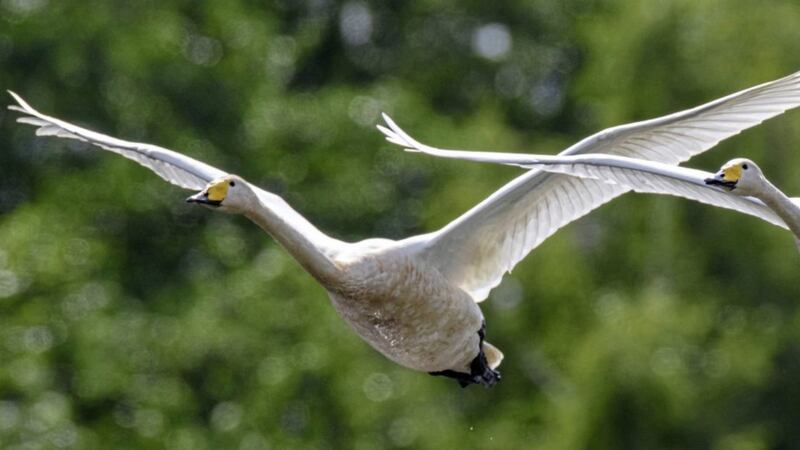THE evocative honking calls of whooper swans, Cygnus cygnus, flying overhead in their V-shaped arrangement against the backdrop of a darkening sky, provided a timely addition to the sense of change celebrated by our ancestors on this day of All Hallows' Eve.
Their haunting sounds, often heard in the night sky now, align perfectly with the macabre pageantry of the festival of Samhain, summer’s end, which is deeply rooted in our pagan past.
The arrival of the whoopers, like the ancient festival itself, signals change; their departure from breeding grounds in Iceland and other subarctic territories to their wintering sites across Ireland.
Halloween, was celebrated by our Celtic relatives as a time of change, when they left summer behind and stepped across to winter. On this night, Oidhe na hAimleise (night of mischief), they feasted around fires and dressed up, believing the normal order of the world was suspended and that the boundaries between the natural and supernatural were temporarily blurred. Gratitude was expressed to the Gods for the harvest and preparations made for the dark days of winter ahead.
It’s not surprising that, with its majestic grace and mystical beauty, the swan was highly regarded by the Celtic chieftains of pre-Christian Ireland. Through the mists, hills and wetlands, swans, they believed, moved effortlessly to the otherworld, often carrying the souls of the dead.
In The Children of Lir legend, Fionnuala and her brothers Aodh, Conn and Fiachra were changed into swans by their evil stepmother Aoife, who, jealous of their love for their father Lir, condemned them to spend 900 years in the form of swans, 300 years at each of three different places in Ireland.
They would only rejoin the human world when a church bell rang out to signal the arrival of Christianity.
Learning of Aoife’s evil act, Lir with the help of a druid’s wand, banished her to life as a demon of the air.
Other myths and legends involving swans include The Birth of Cúchulainn and the The Dream of Óengus, with many of the Celtic nations also cherishing the swan as a sacred bird. The whooper swan was the guardian spirit of Sennen Bay in Cornwall, calling out to warn of coming storms and prevent fishermen going out on to the open sea.
Unlike our resident mute swan, the whooper is a vociferous bird, as its Irish name, Eala ghlórach, noisy swan, suggests.
Eventually that Christian bell did ring for the children of Lir, by the missionary Mochaomhóg on Inishglora, off the coast of Co Mayo, where they were restored to human form, albeit briefly as they were now 900 years old, with death following quickly.
Significantly the arrival of Patrick and Christianity also commenced the process of opposition and hostility by the Church leaders to pagan practices and druid festivals such as Oíche Shamhna. The Celtic communities resisted but around AD834, Pope Gregory IV placed the Feast of All Saints, on November 1, and so October 31 became Holy Evening or Hallowe’en. All Souls’ Day, November 2, was established later.
As with many ancient customs practised by those early communities, tamer remnants from Samhain eve, persist to this day.
Most of our wintering whoopers arrive from Iceland during October and will disperse to settle on lakes, fields and wetlands across the island, from Lough Foyle in the north west to the Wexford Slobs in the south east. Over the next few months, keep your eyes and ears ready for what Yeats called ‘those brilliant creatures’, as they fly overhead, their haunting calls a reminder of our pagan past.








